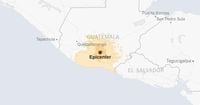Guatemala was shaken on Tuesday, July 8, 2025, by a series of earthquakes that rattled the southern part of the country, prompting widespread concern and emergency responses. The initial tremor, measured at a magnitude of 5.2, struck around mid-afternoon approximately 60 kilometers south of Guatemala City, according to the nation’s seismological institute. This quake was soon followed by numerous aftershocks ranging from magnitudes 3.0 to 5.7, with the strongest aftershock recorded as a 5.7-magnitude tremor near San Vicente Pacaya in Escuintla, as reported by the United States Geological Survey (USGS).
The seismic activity caused significant disruption across multiple departments including Sacatepéquez, Escuintla, and Guatemala, with over 37 tremors reported throughout the day. The National Coordinator for Disaster Reduction (CONRED) issued an orange alert, urging residents to evacuate both public and private buildings as a precautionary measure against potential aftershocks. Emergency teams were dispatched to inspect buildings, hospitals, schools, and roads to assess any damage and ensure public safety.
Despite the intensity of the quakes, authorities confirmed that there were no immediate reports of major building collapses or serious injuries. However, the earthquakes did cause landslides and minor property damage, with local media sharing images of cracked walls and structural impairments in some buildings. Tragically, two people lost their lives when falling rocks crushed their vehicle, and President Bernardo Arévalo confirmed that five people were buried by landslides, two of whom have already been rescued.
The initial 5.2-magnitude quake struck at around 3:41 p.m. Central Time, about 10 miles southwest of Guatemala City, with the USGS initially reporting the magnitude as 5.6 before revising it to 5.7. Seismologists have noted that aftershocks can continue for days, weeks, or even years following a major earthquake and can sometimes be equal or even larger in magnitude than the initial quake, which keeps the region on high alert.
Guatemala's geographical location places it at the convergence of multiple tectonic plates, making it a hotspot for seismic activity. This region has a long history of destructive earthquakes, which is why officials acted swiftly to recommend evacuations and conduct thorough inspections. The country's disaster response agency emphasized the importance of vigilance, stating, "As a preventive measure, we recommend evacuating both public and private buildings," urging residents to follow safety protocols closely.
Emergency responders, including firefighters, were seen working diligently to clear debris and assist those affected by landslides, particularly near Santa Maria de Jesus. The National Coordinator for Disaster Reduction remains active in monitoring the situation and coordinating relief efforts as damage assessments continue.
While the series of earthquakes did not cause widespread devastation, the loss of life and the ongoing risk of aftershocks highlight the persistent dangers faced by communities in this seismically active region. The government has urged citizens to stay informed through official channels and remain prepared for any further seismic events.
In the broader context, this seismic activity in Guatemala follows a pattern of notable earthquakes worldwide in the days preceding July 8, 2025. For instance, a 6.3-magnitude earthquake struck New Zealand on July 7, centered in Riverton at a depth of 22 kilometers, while Alaska experienced multiple tremors ranging from 3.0 to 4.1 magnitude in the same period. Additionally, California reported several quakes, including a 4.6-magnitude event on June 28, and the Philippines experienced a 6.1-magnitude earthquake on June 27. These global seismic events underscore the dynamic nature of the Earth's crust and the importance of preparedness in vulnerable regions.
Authorities in Guatemala continue to monitor seismic activity closely, with the USGS updating shake-severity maps and aftershock data as new information emerges. The situation remains fluid, and while the immediate threat has lessened, the potential for further tremors keeps emergency services and residents on alert.
The recent earthquakes have once again reminded the world of the vulnerability of communities situated along tectonic boundaries and the critical need for robust disaster preparedness and response systems. Guatemala's swift action in issuing alerts and mobilizing emergency teams has been crucial in minimizing harm and coordinating rescue efforts amidst the ongoing seismic unrest.
As Guatemala recovers from this unsettling series of earthquakes, the collective focus remains on ensuring safety, assessing damage, and supporting those affected. The resilience of the people and the dedication of emergency responders stand at the forefront of this effort, as the country navigates the challenges posed by its volatile geological setting.



